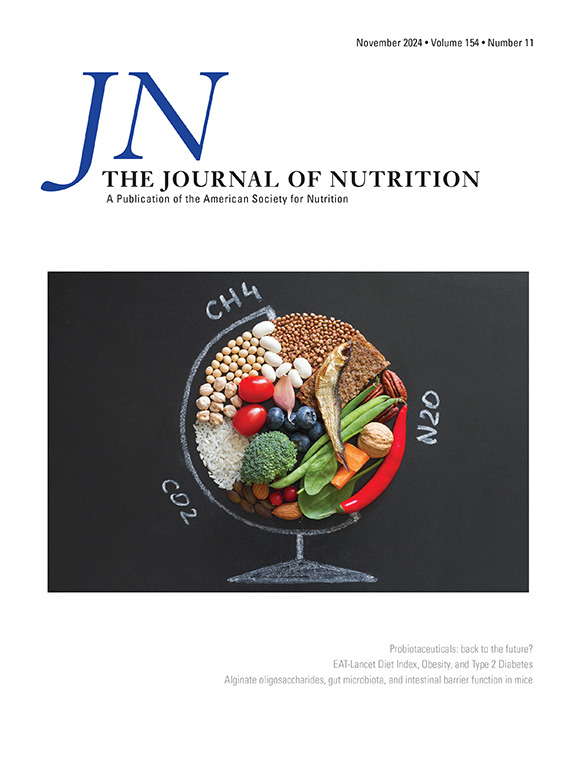Habitual Dietary Collagen Intake Is Lower in Females and Older Irish Adults Compared with Younger Males
IF 3.7
3区 医学
Q2 NUTRITION & DIETETICS
引用次数: 0
Abstract
Background
Collagen ingestion reportedly benefits connective tissues, such as skin, bone, muscle, tendon, and ligament. However, the quantity of collagen intake in the diet of European adults is unknown.
Objectives
This study aims to investigate collagen intake in the habitual diets of Irish adults, and whether it differed according to sex and/or age.
Methods
We conducted secondary analysis of the Irish National Adult Nutrition Survey, which assessed typical dietary intake using a 4-d food diary in 1500 adults, aged 18–90 y. We categorized participants into 3 age groups: young (18–39 y, n = 630), middle-aged (40–64 y, n = 644), and older (≥65 y, n = 226) adults. Collagen composition of each individual food item in the database was determined by applying a percentage collagen value from analytical sources, allowing computation of collagen mean daily intake (MDI), collagen MDI relative to body mass, and collagen/total protein MDI. Differences in intakes between age groups and sexes were evaluated using physical activity level as a covariate.
Results
Collagen MDI for the entire population was 3.2 ± 2.0 g/d, representing 3.6% ± 1.9% total protein intake. Males had higher absolute and relative collagen MDI than females, regardless of age (4.0 ± 2.1 g/d compared with 2.3 ± 1.4 g/d, P < 0.001), whereas older adults had lower absolute collagen MDI than middle-aged adults (2.9 ± 1.8 g/d compared with 3.3 ± 2.0 g/d, P = 0.021).
Conclusions
Collagen intake in the Irish adult population was considered low (relative to total protein intake and to dose–response studies), particularly in females and older individuals. Increasing daily collagen intake may therefore be warranted to optimize the health of collagen-rich tissues.
与年轻男性相比,女性和年长的爱尔兰成年人的习惯性饮食胶原蛋白摄入量较低。
背景:摄入胶原蛋白据称有益于结缔组织,如皮肤、骨骼、肌肉、肌腱和韧带。然而,欧洲成年人饮食中胶原蛋白的摄入量是未知的。目的:调查爱尔兰成年人习惯饮食中的胶原蛋白摄入量,以及胶原蛋白摄入量是否因性别和/或年龄而异。方法:我们对爱尔兰全国成人营养调查进行了二次分析,该调查使用为期四天的食物日记评估了1500名18-90岁成年人的典型饮食摄入量。我们将参与者分为三个年龄组:年轻人(18-39岁,n=630)、中年人(40-64岁,n=644)和老年人(≥65岁,n=226)。数据库中每种食品的胶原蛋白组成是通过应用分析来源的胶原蛋白百分比值来确定的,从而可以计算胶原蛋白平均每日摄入量(MDI)、胶原蛋白相对于体重的MDI以及胶原蛋白/总蛋白MDI。使用体力活动水平作为协变量来评估年龄组和性别之间的摄入量差异。结果:整个人群的胶原蛋白MDI为3.2±2.0 g∙day-1,占总蛋白质摄入量的3.6±1.9%。无论年龄大小,男性的绝对和相对胶原蛋白MDI均高于女性(4.0±2.1 g∙day-1 vs. 2.3±1.4 g∙day-1, p-1 vs. 3.3±2.0g∙day-1, p=0.021)。结论:爱尔兰成年人的胶原蛋白摄入量被认为很低(相对于总蛋白质摄入量和剂量反应研究),特别是在女性和老年人中。因此,增加每日胶原蛋白摄入量可能是有必要的,以优化富含胶原蛋白的组织的健康。
本文章由计算机程序翻译,如有差异,请以英文原文为准。
求助全文
约1分钟内获得全文
求助全文
来源期刊

Journal of Nutrition
医学-营养学
CiteScore
7.60
自引率
4.80%
发文量
260
审稿时长
39 days
期刊介绍:
The Journal of Nutrition (JN/J Nutr) publishes peer-reviewed original research papers covering all aspects of experimental nutrition in humans and other animal species; special articles such as reviews and biographies of prominent nutrition scientists; and issues, opinions, and commentaries on controversial issues in nutrition. Supplements are frequently published to provide extended discussion of topics of special interest.
 求助内容:
求助内容: 应助结果提醒方式:
应助结果提醒方式:


